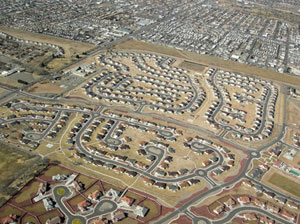 |
 |
|
 |
 |
 |
 |
 |
|
 |
 |
 |
 |
Study Suggests Link Between Urban Sprawl and Abundance of North American Breeding Birds
Overdevelopment in North America is a pressing issue, apparently even for the birds. In fact, in a BioScience article published this year, MBL Ecosystems Center adjunct senior scientist Ivan Valiela suggests circumstantial evidence of a link between urban sprawl and a marked decrease in the abundance of birds breeding in North America.
Valiela and co-author Paulina Martinetto (Universidad Nacional de Mar del Plata) analyzed mountains of observational data collected between 1966 and 2005 by the North American Breeding Bird Survey to conclude that over the past 40 years the total number of birds nesting in the eastern and central U.S. has decreased by as much as 18% in some areas. The losses were especially apparent among species that either resided or migrated within the U.S. and Canada, and were most pronounced among birds preferring open, edge, and wetland habitat—areas commonly impacted by industrialization and urban sprawl.
|
|
|
In spite of enormous habitat losses in the tropical latitudes, there still remain vast expanses of suitable habitats for use of neotropical migrant birds, as is evident in this view of pristine rainforest, taken in east slope of the Andes in Peru, with a river flowing towards the Amazon. Click for large photo
|
The scientists also found that, contrary to what might be expected from the broadly publicized loss of tropical habitats, abundance of species that migrate to the neotropics or beyond did not change significantly or increased over the same time frame.
“We in the developed world have, rightly so, been concerned with the significant losses of natural habitats in the tropics, and have therefore been worried about the possible harm to neotropical migrant bird species, among other organisms,” says Valiela. “Indeed, we recorded surprisingly evident losses of bird abundance, but the results show that it was those species that spend their entire life in the U.S. and Canada that show the greatest losses, rather than the species that migrate to the tropical latitudes.”
 |
|
In North America, more and more of the landscape is being converted to what has been called the wildland-urban interface, where urban sprawl takes over natural landscapes, as seen in this aerial view of the expansion of Albuquerque, New Mexico into the surrounding desert landscapes. Photo by Ivan Valiela. Click for large photo
|
|
“Surely, there are substantial differences among species, some have increased, others have decreased across the last half century,” adds Valiela. “But our research focused mainly on the assemblage of birds present, and, on the whole, birds that migrate to the tropics did not diminish in abundance as those that remain in the U.S. and Canada. As Pogo is often quoted as saying, we have met the enemy, and it is us in the U.S. and Canada that are most impressively degrading bird habitats.”
The study provides a wake-up call for further investigations into these trends and what they mean on a global scale. “The considerable reductions in breeding bird populations we’ve reported may have begun to have consequences that extend across a wide swath of latitudes,” says Valiela. “These expanding footprints seem at an incipient stage.”
|
| |
Citation:
Valiela, Ivan and Paula Martinetto. Changes in Bird Abundance in Eastern North America: Urban Sprawl and Global Footprint? BioScience, April 2007, Vol. 5, No. 4, 360-370.
Other resources:

|
|
 |
 |
|